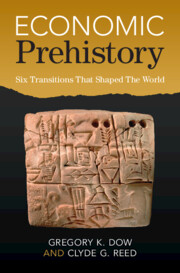Book contents
- Economic Prehistory
- Economic Prehistory
- Copyright page
- Dedication
- Contents
- Figures
- Tables
- Preface
- Acknowledgments
- Abbreviations
- Part I Prologue
- Part II Sedentism and Agriculture
- 3 The Upper Paleolithic
- 4 The Transition to Sedentism
- 5 The Transition to Agriculture
- Part III Inequality and Warfare
- Part IV Cities and States
- Part V Epilogue
- References
- Author Index (Abridged)
- Subject Index
5 - The Transition to Agriculture
from Part II - Sedentism and Agriculture
Published online by Cambridge University Press: 10 February 2023
- Economic Prehistory
- Economic Prehistory
- Copyright page
- Dedication
- Contents
- Figures
- Tables
- Preface
- Acknowledgments
- Abbreviations
- Part I Prologue
- Part II Sedentism and Agriculture
- 3 The Upper Paleolithic
- 4 The Transition to Sedentism
- 5 The Transition to Agriculture
- Part III Inequality and Warfare
- Part IV Cities and States
- Part V Epilogue
- References
- Author Index (Abridged)
- Subject Index
Summary
Sedentary foraging is not identical to agriculture, which involves cultivation of plants and eventually their domestication. Cultivation appears to have developed in southwest Asia during a large negative climate shock called the Younger Dryas. After a prolonged period of warm and wet conditions during which regional population reached a high level, an abrupt reversion to colder and drier conditions forced this large regional population into a few high quality refuge sites where surface water was available from rivers, lakes, marshes, and springs. The resulting spike in local populations at these sites drove down the marginal product of labor in foraging and triggered reallocation of some labor toward cultivation. Once some populations adopted cultivation, learning by doing reinforced the incentive to engage in it. Eventually climate improved in the Holocene, regional population grew, and agriculture spread. We believe this mechanism accounts for the archaeological facts in the case of southwest Asia, and similar mechanisms might account for other pristine agricultural transitions (e.g., in China and sub-Saharan Africa). Our model clarifies the causal roles of climate, geography, technology, population, and migration in the development of pristine agriculture. It also helps explain why certain regions did not experience pristine agricultural transitions.
Keywords
- Type
- Chapter
- Information
- Economic PrehistorySix Transitions That Shaped The World, pp. 157 - 214Publisher: Cambridge University PressPrint publication year: 2023



